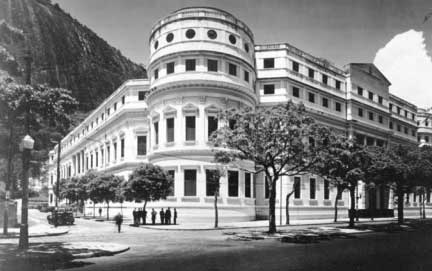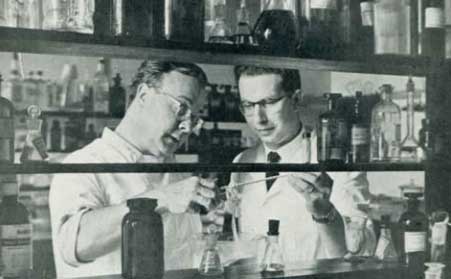Upon taking the chair in 1937, some important issues were needed for Chagas Filho, concerning its strategic vision on the institutionalization of research in basic sciences at the university, and which would direct its intention to implement a new, comprehensive research program. The first concerned the option to stay at the University of Brazil or the Oswaldo Cruz Institute (IOC). Until then, Chagas Filho had accumulated teaching activities at the Faculty of Medicine with research laboratories in Manguinhos and teaching in the Course Application.
By taking possession of the chair, in November 1937, was forced to shut the IOC, by law newly promulgated that prevented the accumulation of positions in public service. Moreover, the same law was responsible for the dismissal of the remaining assistants from the chair, which would allow space for the formation of a new team. The first names to be part of the team of the Laboratory of Biological Physics were Tito Aeneas Leme Lopes, who was in São Paulo, and Lafayette Rodrigues Pereira Filho, who was part of the team when the holder of the chair was his father. Both were contemporaries of Chagas Filho at the Faculty of Medicine.

Campus Praia Vermelha
The next step would be to find a scientific model, a subject and an object on which to build its research agenda, applying the modern techniques of Biophysics. In parallel, occupied his mind the fact that the new discipline required different forms of institutionalization.
The Amazon electric fish Poraquê (Electrophorus electricus) gave him an essential fact: that was the link with the required national science and a model of scientific policy toward modernizing the country through emphasis on training not only of scientists but also of teachers who worked in secondary education, revamping, from above, the entire education system. There was also a strong concern about the low level of professionalization of science in Brazil.
Carlos Chagas Filho opted to set up and deploy your project in university counting especially with the undeniable fact that this was the land on which their resources could trigger social and scientific capital in a much more effective. Some of the actors involved in reshaping the university structure, and occupying key positions in the state bureaucracy high at that time, people were very close to our character.
Once the conditions, there still remained the difficulty of identifying the profiles and names that would be part of the team. If colleges and schools of science were still under implementation, the strategy would be to seek professional among those who, like him, have made a personal choice scientific training, building his own way.

From Manguinhos came Almir Castro, whom he blamed for preparing the course in statistics of small samples applied to genetics. He also came Hertha Meyer, German scientist of Jewish origin, who worked in the vaccine manufacturing laboratory. Due to the impact of its work on cardiac tissue culture, it was possible to built in 1940, with the help of Evandro Chagas and funding of William Guinle, the Tissue Culture Laboratory.
An important recruitment strategy was made between medicine students, especially among the 1st and 2nd year. They did their undergraduate research studying some aspect of electrical potentials of the Poraquê fish (Electrophorus electricus), and this practice of socialization adopted until the mid 50s. According to Darcy de Almeida, she allowed it to broaden the field for research biophysics, it was also the way of training in experimental techniques, besides representing the valuation itself a national theme of ecology.
The major institutional change would come by the end of 1945, with the status elevation of the Laboratory of Biological Physics, who actually was still the Chair of Physics Biological Institute for Biophysics, and maintained, as it should be, very close relations with the democratization of the country, after the Estado Novo. For being a transition phase between two types of research, basic and applied, and because there is not yet a policy-oriented scientific development, Chagas Filho also faced difficulties in order to deploy his entire science project at the university. It was necessary to establish salary compensations to enable the retention of researchers, and they were mainly from Guinle funds and grants from the Rockefeller Foundation.
Adapted text from the article: Um estudo de caso: a criação do Instituto de Biofísica, by Ana Luce G. S. Lima.







